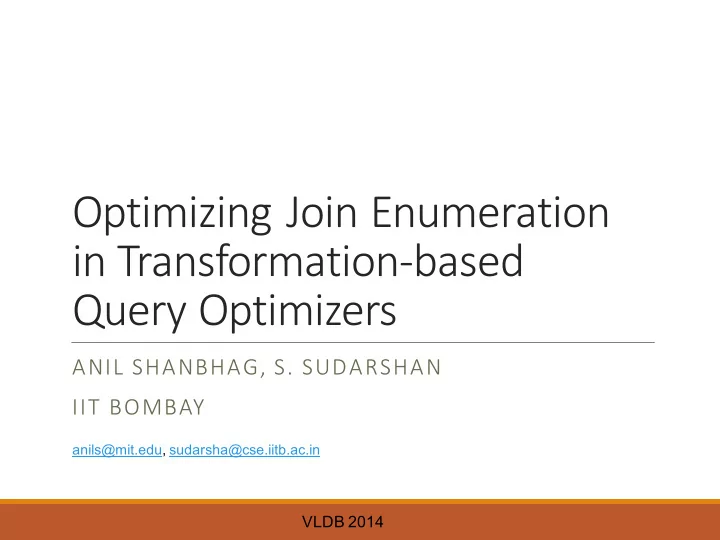

Optimizing ¡Join ¡Enumeration ¡ in ¡Transformation-‑based ¡ Query ¡Optimizers ANIL ¡SHANBHAG, ¡S. ¡SUDARSHAN IIT ¡BOMBAY anils@mit.edu, sudarsha@cse.iitb.ac.in VLDB 2014
Query ¡Optimization: ¡Quick ¡Background System ¡R ¡algorithm ◦ Dynamic ¡programming ¡ algorithm ¡to ¡find ¡best ¡join ¡order ◦ Time ¡complexity: ¡ ¡O(3 n ) ¡for ¡bushy ¡join ¡orders ◦ Plan ¡space ¡considered ¡includes ¡cross ¡products For ¡some ¡common ¡join ¡topologies ¡ ¡#cross-‑product ¡free ¡intermediate ¡join ¡ results ¡is ¡polynomial ◦ E.g. ¡chain, ¡cycle, ¡.. Can ¡we ¡reduce ¡optimization ¡time ¡by ¡avoiding ¡cross ¡products? ◦ Algorithms ¡ for ¡generation ¡of ¡cross-‑product ¡free ¡join ¡space ◦ Bottom ¡up: ¡ ¡DPccp (Moerkotte and ¡Newmann [VLDB06]) ◦ Top-‑down: ¡ ¡ ¡TDMinCutBranch (Fender ¡et ¡al. ¡[ICDE11]), ¡TDMinCutConservative (Fender ¡et ¡al. ¡[ICDE12]) ◦ Time ¡complexity ¡is ¡polynomial ¡ if ¡#cross-‑product ¡free ¡intermediate ¡join ¡results ¡is ¡ polynomial ¡ in ¡size 2 IIT BOMBAY
Cross-‑Product-‑Free ¡Join ¡Order ¡ Enumeration ¡using ¡Graph ¡Partitioning Key ¡idea ¡for ¡avoiding ¡cross ¡products ¡while ¡finding ¡best ¡join ¡tree: ¡ For ¡set ¡S ¡of ¡relations, ¡find ¡all ¡ways ¡to ¡ ¡ ¡ ¡ ¡ ¡ ¡ ¡ ¡ ¡ ¡ ¡ ¡ ¡ ¡ ¡ ¡ ¡ ¡ ¡ ¡ ¡ ¡ ¡ ¡ ¡ ¡ ¡ ¡ ¡ ¡ ¡ ¡ ¡ ¡ ¡ ¡ ¡ ¡ ¡ ¡ ¡ ¡ ¡ ¡ ¡ ¡ ¡ ¡ ¡ ¡ ¡ ¡ ¡ ¡ ¡ ¡ S partition ¡S ¡into ¡S1 ¡and ¡S2 ¡s.t. S2 S1 R1 R2 ◦ the ¡join ¡graph ¡of ¡S1 ¡is ¡connected, ¡ and ¡so ¡is ¡the ¡join ¡graph ¡of ¡S2 ◦ there ¡is ¡an ¡edge ¡(join ¡predicate) ¡between ¡S1 ¡and ¡S2 R4 R3 Simple ¡recursive ¡algorithm ¡to ¡find ¡best ¡plan ¡in ¡ ¡ ¡ ¡ ¡ ¡ ¡ ¡ ¡ ¡ ¡ ¡ ¡ ¡ ¡ ¡ ¡ ¡ ¡ ¡ ¡ ¡ cross-‑product ¡free ¡join ¡space ¡using ¡partitioning ¡ ¡ ¡ ¡ ¡ ¡ ¡ ¡ ¡ ¡ ¡ ¡ ¡ ¡ ¡ ¡ ¡ ¡ ¡ ¡ ¡ ¡ ¡ ¡ ¡ ¡ ¡ ¡ as ¡above Efficient ¡algorithms ¡for ¡finding ¡all ¡ways ¡to ¡partition ¡S ¡into ¡S1 ¡and ¡S2 ¡as ¡above ◦ MinCutLazy (Dehaan and ¡Tompa [SIGMOD07]) ¡ ◦ Fender ¡et. ¡al ¡proposed ¡MinCutBranch [ICDE11] ¡and ¡MinCutConservative [ICDE12] ◦ MinCutConservative is ¡the ¡most ¡efficient ¡currently. 3 IIT BOMBAY
Volcano/Cascades ¡Framework ¡for ¡Query ¡ Optimization Based ¡on ¡equivalence ¡rules: ¡e.g. ¡ ¡A ¡ ⋈ B ¡↔ ¡B ¡ ⋈ A Key ¡benefit: ¡easy ¡to ¡add ¡rules ¡to ¡deal ¡with ¡new ¡operators ◦ e.g. ¡outerjoin group-‑by/aggregate, ¡ limit, ¡... ◦ Memoization technique ¡which ¡generalizes ¡System ¡R ¡style ¡dynamic ¡programming ¡ applicable ¡even ¡with ¡equivalence ¡rules Used ¡in ¡SQL ¡Server, ¡Tandem, ¡and ¡Greenplum, ¡and ¡several ¡other ¡databases, ¡ increasing ¡adoption Transformation ¡rule ¡sets ¡for ¡join ¡order ¡optimization: Commutativity + ¡ Pellenkoft ¡et. ¡al ¡ RS-‑B1 RS-‑B2 Left ¡Associativity: ¡ [VLDB97] ¡suggest ¡ Takes ¡O(4^n) ¡time ¡ new ¡ruleset: ¡ O(3^n) ¡time ¡ Both ¡the ¡rulesets generate ¡join ¡orders ¡with ¡cross-‑products. ¡ ◦ Key ¡contribution ¡of ¡paper: ¡Efficient ¡rulesets that ¡avoid ¡cross-‑products ¡ 4 IIT BOMBAY
Rulesets with ¡Cross-‑Product ¡Suppression ¡(CPS) RS-‑B1-‑CPS/RS-‑B2-‑CPS: ¡modification ¡of ¡RS-‑B1/RS-‑B2 ¡to ¡suppress ¡cross-‑ products, ¡i.e. ¡block ¡transformation ¡if ¡the ¡result ¡has ¡cross-‑product RS-‑B1-‑CPS ¡and ¡RS-‑B2-‑CPS ¡have ¡been ¡used ¡in ¡some ¡implementations ◦ but ¡not ¡obvious ¡ if ¡they ¡are ¡complete, ¡i.e. ¡generate ¡the ¡entire ¡search ¡space 5 IIT BOMBAY
RS-‑B1-‑CPS ¡ ¡ ¡ ¡ ¡ ¡ ¡ ¡ ¡ ¡ ¡ ¡ ¡ ¡ ¡ ¡ ¡ ¡ ¡ ¡ ¡ ¡ ¡ ¡ ¡ ¡ ¡ ¡ ¡ ¡ Proof ¡of ¡Completeness Theorem : ¡RS-‑B1-‑CPS ¡is ¡complete ¡i.e. ¡any ¡cross-‑product ¡free ¡ tree ¡Q1 ¡can ¡be ¡converted ¡to ¡any ¡other ¡cross-‑product ¡free ¡tree ¡ Q2 ¡using ¡RS-‑B1-‑CPS Intuition ¡for ¡the ¡proof ◦ Step ¡1: ¡Given ¡any ¡arbitrary ¡cross-‑product-‑free ¡tree ¡Q1 ¡we ¡can ¡convert ¡it ¡ into ¡a ¡canonical ¡cross-‑product ¡free ¡left-‑deep ¡tree ¡ Qc= ¡(..((R1 ⋈ R2) ⋈ R3)..) ⋈ Rk) ¡with ¡relations ¡in ¡sorted ¡order ¡ using ¡RS-‑B1-‑CPS ◦ Step ¡2: ¡Above ¡steps ¡can ¡be ¡reversed ¡using ¡RS-‑B1-‑CPS ¡for ¡any ¡cross-‑ product ¡free ¡tree ◦ Can ¡go ¡from ¡any ¡Q1 ¡to ¡any ¡Q2 ¡as ¡above ¡via ¡Qc 6 IIT BOMBAY
RS-‑B2-‑CPS ¡is ¡Incomplete Some ¡cross-‑product ¡free ¡trees ¡may ¡not ¡be ¡reachable ¡from ¡other ¡cross-‑ product ¡free ¡trees ¡using ¡RS-‑B2-‑CPS. Proof ¡of ¡incompleteness ¡of ¡RS-‑B2-‑CPS ¡using ¡counter-‑example ¡below ◦ Q ¡and ¡Q2 ¡are ¡both ¡cross-‑product ¡free ¡join ¡trees ◦ Starting ¡with ¡Q, ¡we ¡can ¡go ¡to ¡Q2 ¡only ¡via ¡application ¡of ¡exchange ¡rule ¡at ¡ root ¡join ¡op ◦ This ¡will ¡always ¡result ¡in ¡an ¡intermediate ¡tree ¡with ¡cross-‑product ¡! 7 IIT BOMBAY
Problem ¡and ¡Potential ¡Fix Problem: ¡RS-‑B1-‑CPS ¡and ¡RS-‑B2 ¡are ¡complete, ¡however ◦ RS-‑B1-‑CPS ¡generates ¡exponential ¡number ¡of ¡duplicates ¡(Pellenkoft et ¡al.) ¡ ◦ RS-‑B2 ¡explores ¡significantly ¡larger ¡search ¡space ¡(no ¡CPS) Key ¡idea: ¡incorporate ¡graph-‑partitioning ¡based ¡top-‑down ¡ enumeration ¡into ¡Volcano/Cascades ¡framework 8 IIT BOMBAY
AND-‑OR ¡DAG ¡Representation ¡in ¡ Volcano/Cascades Repeatedly ¡apply ¡a ¡set ¡of ¡rules ¡until ¡fixedpoint Store ¡the ¡alternatives ¡efficiently ¡using ¡AND-‑OR ¡DAG ¡representation ¡. ¡ Example ¡shows ¡join ¡enumeration ¡for ¡a ¡simple ¡query ¡in ¡ transformation-‑based ¡QO ¡: ¡ ¡ 9 IIT BOMBAY
Join ¡Sets For ¡applying ¡graph-‑partitioning ¡based ¡enumeration, ¡we ¡ need ¡to ¡create ¡a ¡join ¡graph ¡consisting ¡of ¡nodes ¡being ¡ joined A ¡ maximal ¡join ¡set at ¡an ¡equivalence ¡node ¡E ¡is ¡a ¡ maximal ¡set ¡of ¡equivalence ¡nodes ¡Ei ¡being ¡joined ¡below ¡ E ¡such ¡that ¡none ¡of ¡the ¡Ei have ¡any ¡join ¡operators ¡below ¡ them. There ¡can ¡be ¡multiple ¡maximal ¡join ¡sets ¡at ¡an ¡ equivalence ¡node ◦ we ¡store ¡all ¡of ¡them. In ¡the ¡example ¡to ¡the ¡right, ¡at ¡E 0 ◦ (R 1 , ¡E 3 ¡ , ¡R 3 ) ¡is ¡a ¡maximal ¡join ¡set, ¡ ◦ But ¡(E 1 , ¡R 3 ) ¡is ¡not ¡since ¡E1 ¡has ¡join ¡operator ¡below ¡it 10 IIT BOMBAY
Recommend
More recommend